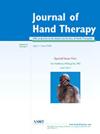辅助技术对中风患者上肢功能的影响:系统回顾与荟萃分析
IF 2.1
4区 医学
Q2 ORTHOPEDICS
引用次数: 0
摘要
背景在脑卒中康复中,选择合适的辅助器具对患者至关重要。具体来说,器械的选择可以显著影响上肢的功能恢复,影响他们的整体活动或功能任务。目的全面分析和总结卒中患者常用辅助器具治疗上肢功能的随机对照试验的临床证据。方法为了评价辅助器具对脑卒中患者的作用,我们对综合结果进行定性总结,如治疗干预、强度、结局和结果总结,并检查偏倚风险、异质性、平均差、95%置信区间和i平方值。为了进行分析,我们使用了RoB 2和RevMan 5.4。结果定性综合纳入31项随机对照试验。随机化过程和结果报告显示出最小的偏倚,但存在预期干预措施的偏倚问题,并且缺少结果数据令人担忧。定量综合纳入16项随机对照试验。fugel - meyer评估-上肢功能(FMA-UE)评分在两组间有显著差异,总平均差异(95%置信区间)为2.40(0.21,4.60),异质性值为Tau2 = 0.32,卡方= 8.22,自由度= 8 (p = 0.41), FMA-UE的异质性值为I2 = 3%,慢性卒中患者的总体效果检验Z = 2.14 (p = 0.03)。然而,在所有其他结果测量中没有显著差异。结论除了慢性脑卒中患者的FMA-UE评分外,超肢机器人在改善上肢功能方面没有明显优于常规治疗方法。FMA-UE的平均差异也低于最小重要差异。尽管如此,上肢机器人的使用可能有助于增强中风患者的功能,因为这些设备支持临床医生,并在特定的时间框架内实现更多的运动重复。本文章由计算机程序翻译,如有差异,请以英文原文为准。
Assistive technology on upper extremity function for stroke patients: A systematic review with meta-analysis
Background
In stroke rehabilitation, the selection of appropriate assistive devices is of paramount importance for patients. Specifically, the choice of device can significantly influence the functional recovery of the upper limb, impacting their overall activities or functional tasks.
Objectives
This review aimed to comprehensively analyze and summarize the clinical evidence from randomized controlled trials (RCTs) regarding the therapeutic effects of commonly used assistive devices on upper extremity function in patients with stroke.
Methods
To evaluate assistive devices for patients with stroke, we summarized qualitatively throughout synthesis of results, such as therapeutic intervention, intensity, outcome, and summary of results, and examined risk of bias, heterogeneity, mean difference, 95% confidence interval, and I-squared value. To analyze, we used RoB 2 and RevMan 5.4.
Results
The qualitative synthesis included 31 RCTs. The randomization process and the reporting of results showed minimal bias, but there were issues with bias from intended interventions, and missing outcome data presented some concerns. The quantitative synthesis included 16 RCTs. There was a significant difference in the Fugl-Meyer assessment-upper extremity functioning (FMA-UE) scores between the groups, with a total mean difference (95% confidence interval) of 2.40 (0.21, 4.60), heterogeneity values were Tau2 = 0.32, chi-square = 8.22, degrees of freedom = 8 (p = 0.41), and I2 = 3% for FMA-UE and the test for the overall effect produced Z = 2.14 (p = 0.03) in patients with chronic stroke. However, there was no significant difference in all other outcome measures.
Conclusions
Upper-limb robots did not demonstrate significant superiority over conventional treatments in improving function of upper limbs, with the exception of FMA-UE scores for patients with chronic stroke. The mean difference of FMA-UE was also lower than minimally important difference. Nonetheless, the usage of upper-limb robots may contribute to enhanced function for patients with stroke, as those devices support clinicians and enable a greater number of movement repetitions within specific time frames.
求助全文
通过发布文献求助,成功后即可免费获取论文全文。
去求助
来源期刊

Journal of Hand Therapy
医学-外科
CiteScore
3.50
自引率
10.00%
发文量
65
审稿时长
19.2 weeks
期刊介绍:
The Journal of Hand Therapy is designed for hand therapists, occupational and physical therapists, and other hand specialists involved in the rehabilitation of disabling hand problems. The Journal functions as a source of education and information by publishing scientific and clinical articles. Regular features include original reports, clinical reviews, case studies, editorials, and book reviews.
 求助内容:
求助内容: 应助结果提醒方式:
应助结果提醒方式:


